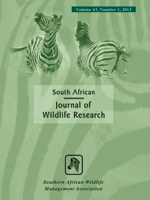Natal dispersal is a key spatially structuring demographic process for many species but is poorly known for wide-ranging carnivores, especially in cryptic, solitary species such as the leopard (Panthera pardus). We report a failed long-distance natal dispersal of a subadult male leopard (M67) in Maputaland, southern Africa, the longest reported for the species. M67 traversed three countries covering a minimum distance of 352.8 km, with a straight-line distance of 194.5 km between his natal range and the site of his death. His movements reveal potential linkages between leopard populations in southern Mozambique, Swaziland, northern KwaZulu-Natal and the Greater Kruger Ecosystem, which might represent a functioning leopard metapopulation currently regarded as separate conservation units.
How to translate text using browser tools
1 April 2013
Long-Distance Natal Dispersal in Leopard Reveals Potential for a Three-Country Metapopulation
Julien Fattebert,
Tristan Dickerson,
Guy Balme,
Rob Slotow,
Luke Hunter
ACCESS THE FULL ARTICLE
leopard
Maputaland
natal dispersal
Panthera pardus
population linkage





